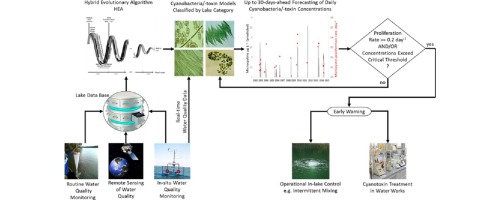Harmful Algae ( IF 6.6 ) Pub Date : 2017-10-10 , DOI: 10.1016/j.hal.2017.09.003 Friedrich Recknagel , Philip T. Orr , Michael Bartkow , Annelie Swanepoel , Hongqing Cao

|
An early warning scheme is proposed that runs ensembles of inferential models for predicting the cyanobacterial population dynamics and cyanotoxin concentrations in drinking water reservoirs on a diel basis driven by in situ sonde water quality data. When the 10- to 30-day-ahead predicted concentrations of cyanobacteria cells or cyanotoxins exceed pre-defined limit values, an early warning automatically activates an action plan considering in-lake control, e.g. intermittent mixing and ad hoc water treatment in water works, respectively. Case studies of the sub-tropical Lake Wivenhoe (Australia) and the Mediterranean Vaal Reservoir (South Africa) demonstrate that ensembles of inferential models developed by the hybrid evolutionary algorithm HEA are capable of up to 30 days forecasts of cyanobacteria and cyanotoxins using data collected in situ. The resulting models for Dolicospermum circinale displayed validity for up to 10 days ahead, whilst concentrations of Cylindrospermopsis raciborskii and microcystins were successfully predicted up to 30 days ahead. Implementing the proposed scheme for drinking water reservoirs enhances current water quality monitoring practices by solely utilising in situ monitoring data, in addition to cyanobacteria and cyanotoxin measurements. Access to routinely measured cyanotoxin data allows for development of models that predict explicitly cyanotoxin concentrations that avoid to inadvertently model and predict non-toxic cyanobacterial strains.
中文翻译:

通过推论模型预警饮用水水库中蓝细菌和氰毒素的超标浓度
提出了一种预警方案,该方案运行推断模型的集合,以基于原位探空仪水质数据的预测,以饮用水为基础,预测饮用水水库中的蓝细菌种群动态和氰毒素浓度。当提前10到30天的蓝细菌细胞或蓝藻毒素的预测浓度超过预定的极限值时,考虑到湖内控制,预警将自动激活行动计划,例如在水厂分别进行间歇混合和临时水处理。对亚热带维文霍湖(澳大利亚)和地中海瓦尔水库(南非)的案例研究表明,使用混合进化算法HEA开发的推论模型集合能够利用从中收集的数据对蓝细菌和蓝藻毒素进行长达30天的预测原地。所产生的杜鹃花环生模型在长达10天的时间内显示出有效性,而在多达30天的时间内成功预测到了Cylindrospermopsis raciborskii和微囊藻毒素的浓度。实施拟议的饮用水水库计划仅通过原地利用就可以增强当前的水质监测实践监测数据,除了蓝细菌和蓝藻毒素的测量。访问常规测得的蓝藻毒素数据可以开发模型,这些模型可以明确预测蓝藻毒素的浓度,从而避免无意间对无毒蓝藻菌株进行建模和预测。



























 京公网安备 11010802027423号
京公网安备 11010802027423号